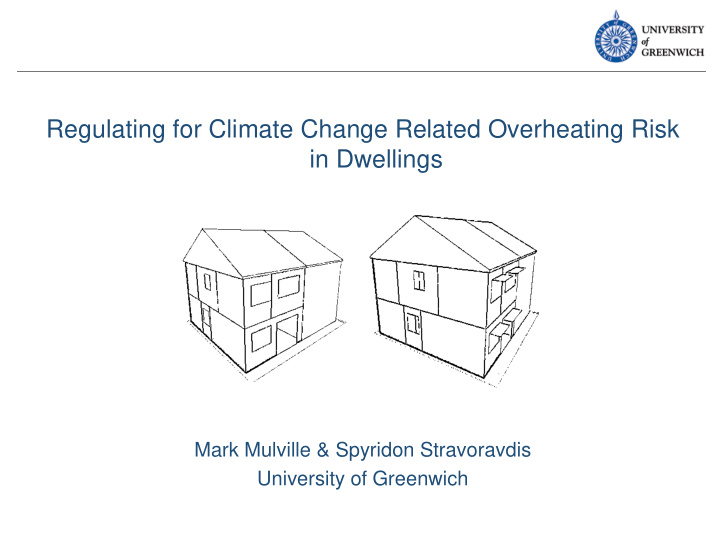



Regulating for Climate Change Related Overheating Risk in Dwellings Mark Mulville & Spyridon Stravoravdis University of Greenwich
Background & Research Aims Background • Building regulations in cool climates optimise dwellings for heat retention • Evidence that some dwellings already experience significant overheating - likely to get worse over time due to climate change • Current approach (in regulations) to overheating assessment may not be fit for purpose as they are largely based on historic data, take a simplistic (steady state) approach, allow for unrealistic user adaptations and are focused on the point of handover • Potentially more accurate dynamic simulation methods may be problematic due to the level of resource and training required Research Aims • Consider the level of potential overheating risk in dwellings, in cool climates associated with climate change • Develop an alternative industry focused, risk based approach that can account for building configuration, location, predicted climate change and incorporate adaptation planning
Methodology • ‘Typical’ (UK) Semi-Detached dwelling modelled in Ecotect and exported to HTB2 • Construction specification (5) (heat retention), construction method (3) (mass), orientation (2) and window opening (4) varied to consider a range of specifications (reflecting recent and emerging regulations and standards) • Models ‘run’ using weather files based on UKCP09 predictions and developed as part of the PROMETHEUS* project at the University of Exeter 50 th percentile ‘medium’ scenario predictions chosen based on Design Summer • Year (DSYs) for a base case and the 2030s, 2050s and 2080s • Resultant operational temperatures measured against adaptive thermal comfort criteria to predict levels of overheating • Outputs used to develop a ‘risk matrix’ corresponding to construction specification, mass, orientation etc…. allowing for the level of risk associated with the given configuration to be visualised. *See: Eames M., Kershaw T. and Coley D. (2011). “On the creation of future probabilistic design weather years from UKCP09.” Building Services Engineering Research and Technology 32: 127-142.
Findings • Level of predicted overheating • Thermal Mass and increased increases over time; ventilation offer benefits but both have limitations • and as heat retention parameters increase (more insulation and air • Metrics a cause for concern tightness etc.) particularly in relation to overnight temperatures and thermal mass • Passivhaus compliance may offer some protection compared ‘advanced fabric’ options alone Figure 2: Temp. frequency curve – Overtime Figure 1: Temp. frequency curve – Across standards Figure 4: Daily temperature profile (Good Fabric – 2030s)
Proposed Approach NORTH-SOUTH - LONDON • Attempts to consider a range LTM MTM HTM of possible dwelling configurations and to look CLOSED CLOSED CLOSED SLIGHT SLIGHT SLIGHT beyond the point of handover HALF HALF HALF FULL FULL FULL • Considers potential user 2006 adaptations 2030s DSY 2010 • Allows for the level of risk to GF be visualised AF PH • Interventions made now to reduce future overheating 2006 = UK PART L 2006 Low Risk risk may increase short term 2010 = UK PART L 2010 Medium Risk energy use – an approach GF = Good Fabric High Risk linked to adaptation planning AD = Advanced Fabric is proposed PH = Passive House • Focused on delivering whole Mulville, M. & Stravoravdis, S. (2016). The Impact of life performance of Regulations on Overheating Risk in Dwellings. DOI:10.1080/09613218.2016.1153355
Conclusions • Current approach to overheating risk assessment may not be fit for purpose • Potential for significant climate change related overheating • Proposed approach is industry focused and allows for a range of building configurations/ specifications to be considered • A whole of life approach incorporating adaptation planning to avoid near term energy use increases in favour of reducing predicted overheating risk • Further exploration of window opening behaviour during warm periods particularly in urban areas would be of benefit • The appropriateness of overheating metrics could also be further explored, particularly in relation to overnight temperatures and the impacts of thermal mass • What defines a ‘typical’ building requires careful consideration • A range of buildings that fall outside the ‘typical’ definition would remain and these would require more resource intensive dynamic simulation to predict the level of risk
Thank You Mark Mulville Department of Built Environment University of Greenwich m.mulville@gre.ac.uk
Recommend
More recommend